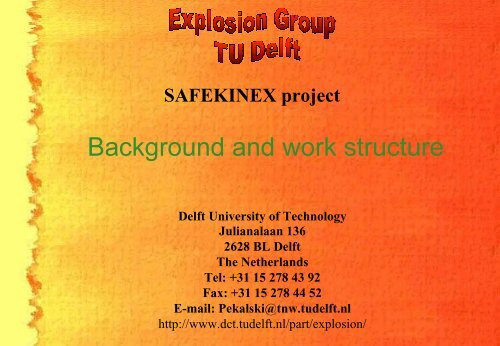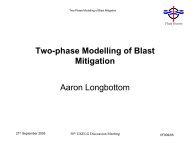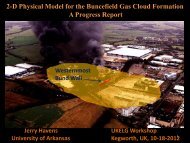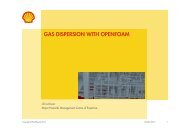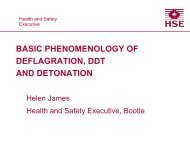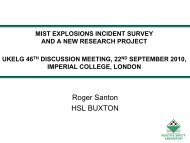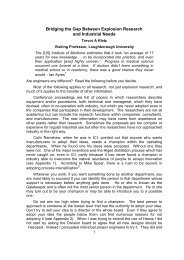SAFEKINEX project - ukelg
SAFEKINEX project - ukelg
SAFEKINEX project - ukelg
Create successful ePaper yourself
Turn your PDF publications into a flip-book with our unique Google optimized e-Paper software.
<strong>SAFEKINEX</strong> <strong>project</strong><br />
Delft University of Technology<br />
Julianalaan 136<br />
2628 BL Delft<br />
The Netherlands<br />
Tel: +31 15 278 43 92<br />
Fax: +31 15 278 44 52<br />
E-mail: Pekalski@tnw.tudelft.nl<br />
http://www.dct.tudelft.nl/part/explosion/
Acknowledgements<br />
To all partners for their essential contribution<br />
Special thanks to:<br />
•Prof. John Griffiths<br />
•Prof. Martin Braithwaite<br />
•Dr Battin-Leclerc<br />
•Dr Kai Holtappels and Dr Volkmar Schröder
Accidents in process industry
Can an explosion be avoided<br />
Explosion Indices<br />
Explosion sensitivity:<br />
Explosion severity:<br />
LEL, UEL (FL), LOC, MIE, AIT, CFT, MIT,<br />
MESG, LFP, UFP (flash points),<br />
ignition delay time (AIT), induction time (CFT)<br />
selfheating (smouldering) temp<br />
P max , (dP/dt) max , K st , K g , flame speed,<br />
burning velocity (laminar, turbulent),<br />
pressure pulse<br />
Both engineering and chemical factors<br />
play a role in these explosion indices
Effects of running conditions on explosion sensitivity indices<br />
Indices related to the<br />
explosion sensitivity<br />
Lower explosion lim it<br />
(LEL)<br />
Upper explosion limit<br />
(UEL)<br />
Lower flash point<br />
(LFP)<br />
Upper flash point<br />
(UFP)<br />
Minimum auto-ignition<br />
temperature (AIT)<br />
Minimum ignition<br />
energy (MIE)<br />
Maximum<br />
experimental safe gap<br />
(MESG)<br />
Limiting oxygen<br />
concentration (LOC)<br />
Effect of<br />
increased<br />
pressure<br />
Decreases<br />
slightly<br />
Effect of<br />
increased<br />
temperature<br />
Decreases<br />
Effect of<br />
increased<br />
turbulence<br />
Increases<br />
Increases Increases Decreases<br />
Increases not applicable Increases<br />
Increases not applicable Increases<br />
Decreases not applicable Increases<br />
Decreases Decreases Increases<br />
Decreases Decreases Decreases<br />
Decreases Decreases Increases
Effects of running conditions on explosion severity indices<br />
Explosion<br />
severity<br />
term<br />
Flame speed<br />
(S f )<br />
Effect of increased<br />
pressure<br />
Effect of<br />
increased<br />
temperature<br />
Increases<br />
Effect of increased<br />
turbulence<br />
May slightly<br />
Increases strongly<br />
decrease or increase<br />
P max Increases linearly Decreases May slightly increase<br />
(dP/dt) max Increases linearly Can increase Increases strongly<br />
or decrease<br />
K-value: (K G Increases linearly Can increase Increases strongly<br />
or K St )<br />
or decrease<br />
Conclusion:<br />
All explosion indices are affected by changes in<br />
pressure, temperature, turbulence, etc.
Effect of pressure, temperature, and fuel concentration<br />
on Flammability Limits
Flammability limits (FL) are affected by<br />
1) Temperature<br />
2) Pressure<br />
3) Fuel type and concentration<br />
4) Oxidiser type and concentration<br />
5) Size of vessel and dimension<br />
6) Ignition type and strength<br />
7) Direction of flame propagation<br />
8) Turbulence<br />
9) Impurities<br />
10) Catalytic material<br />
11) Ignition criterion<br />
12) Cool flame phenomena (at elevated conditions)
Importance of reaction kinetic knowledge
GENERAL COMBUSTON KINETICS<br />
For any hydrocarbon at stiochiometric concentration<br />
C x H y O z + (x+y/4-z/2)O 2 → xCO 2 + y/2H 2 O<br />
The general oxidation scheme shows only the overall reaction<br />
and contains absolutely no information about the intermediate<br />
species and the oxidation mechanism<br />
Therefore<br />
1) The oxidation path and intermediate products are unknown<br />
2) Reaction time is unknown<br />
The oxidation reactions can be divided into three<br />
mechanisms namely: initiation, propagation and termination<br />
We have experts in the audience on this subject
General oxidation scheme with respect to<br />
temperature<br />
branching<br />
2 OH<br />
H 2<br />
O 2<br />
RH<br />
HO 2<br />
+ alkene<br />
O-heterocycle<br />
+ OH<br />
Oxygenated<br />
products<br />
INTERMEDIATE TEMP<br />
+ O 2<br />
branching<br />
C-H split<br />
H + alkene R + O 2<br />
RO 2<br />
QOOH<br />
OOQHO 2<br />
+ radical<br />
+ O 2<br />
or RH<br />
C-C<br />
split<br />
products<br />
branching<br />
O + OH<br />
Lower<br />
alkane and<br />
alkene<br />
ROOH<br />
RO<br />
Oxygenated<br />
products<br />
x OH + products<br />
HIGH TEMPERATURE<br />
LOW TEMPERATURE
WHAT IS THE PROPER WAY FORWARD<br />
SAFETY<br />
<strong>SAFEKINEX</strong><br />
KINETICS<br />
BAM, INERIS, WUT,<br />
UK, BASF, TUW, TUD<br />
CNRS, VUB, UL, TUD<br />
Constrain: Gas phase kinetics (no heterogeneous reactions)<br />
next
<strong>SAFEKINEX</strong> work overview<br />
C1-C3<br />
C4-C10<br />
aromats<br />
SAFETY<br />
(gas phase)<br />
Explosion modelling<br />
E x p e r i m e n t s<br />
CVB:<br />
LEL<br />
UEL<br />
P max<br />
(dP/dt) max<br />
MIE<br />
CVB,RCM, ST:<br />
IDT<br />
AIT<br />
CFT<br />
ISC<br />
KINETICS<br />
(gas phase)<br />
Validation / Reduction<br />
Detailed<br />
kinetic<br />
modelling<br />
C1-C3<br />
C4-C10<br />
aromats<br />
Data base +<br />
Prediction<br />
of explosion indices<br />
Reactive flow<br />
Comp.Fluid Dynamics<br />
Flow Explosion Tests<br />
Industrial Applications<br />
Process safety<br />
Engineering<br />
Process control<br />
CVB = Constant Volume Bomb; RCM = Rapid Compression Machine<br />
LEL = Lower Explosion Limit ; UEL Upper Explosion Limit<br />
IDT = Induction Time; AIT = Auto-Ignition Temperature;


